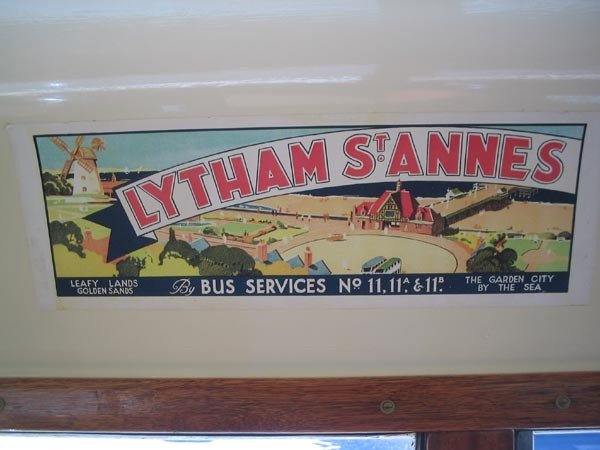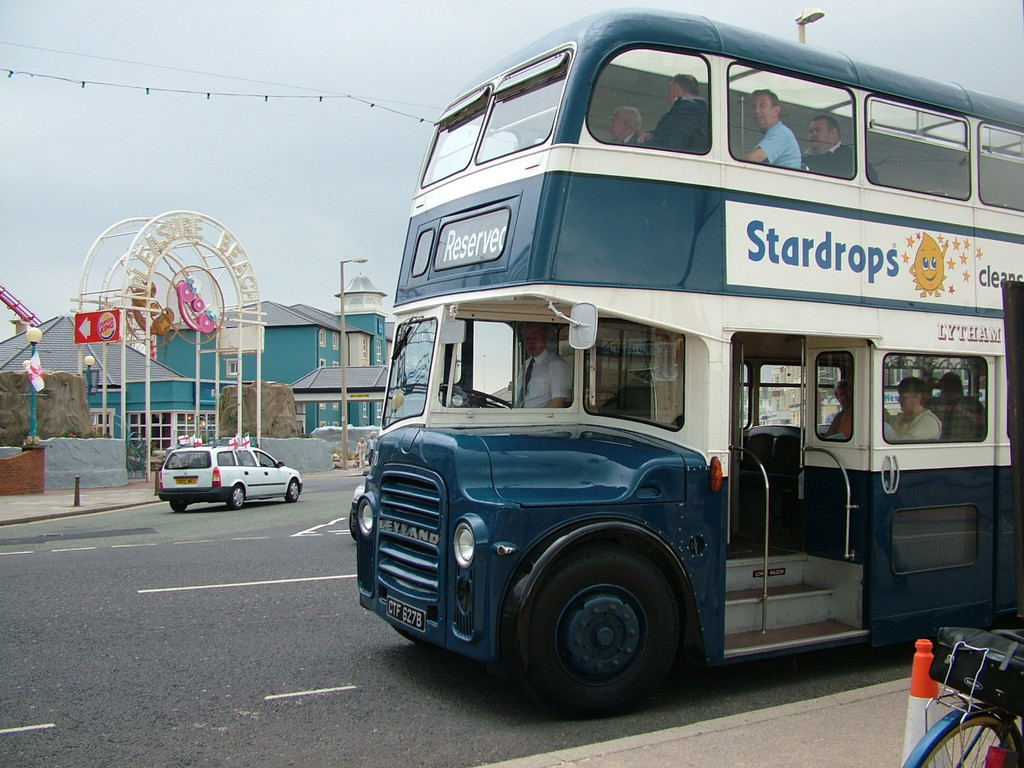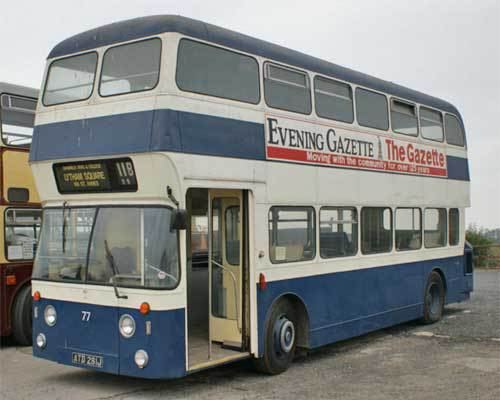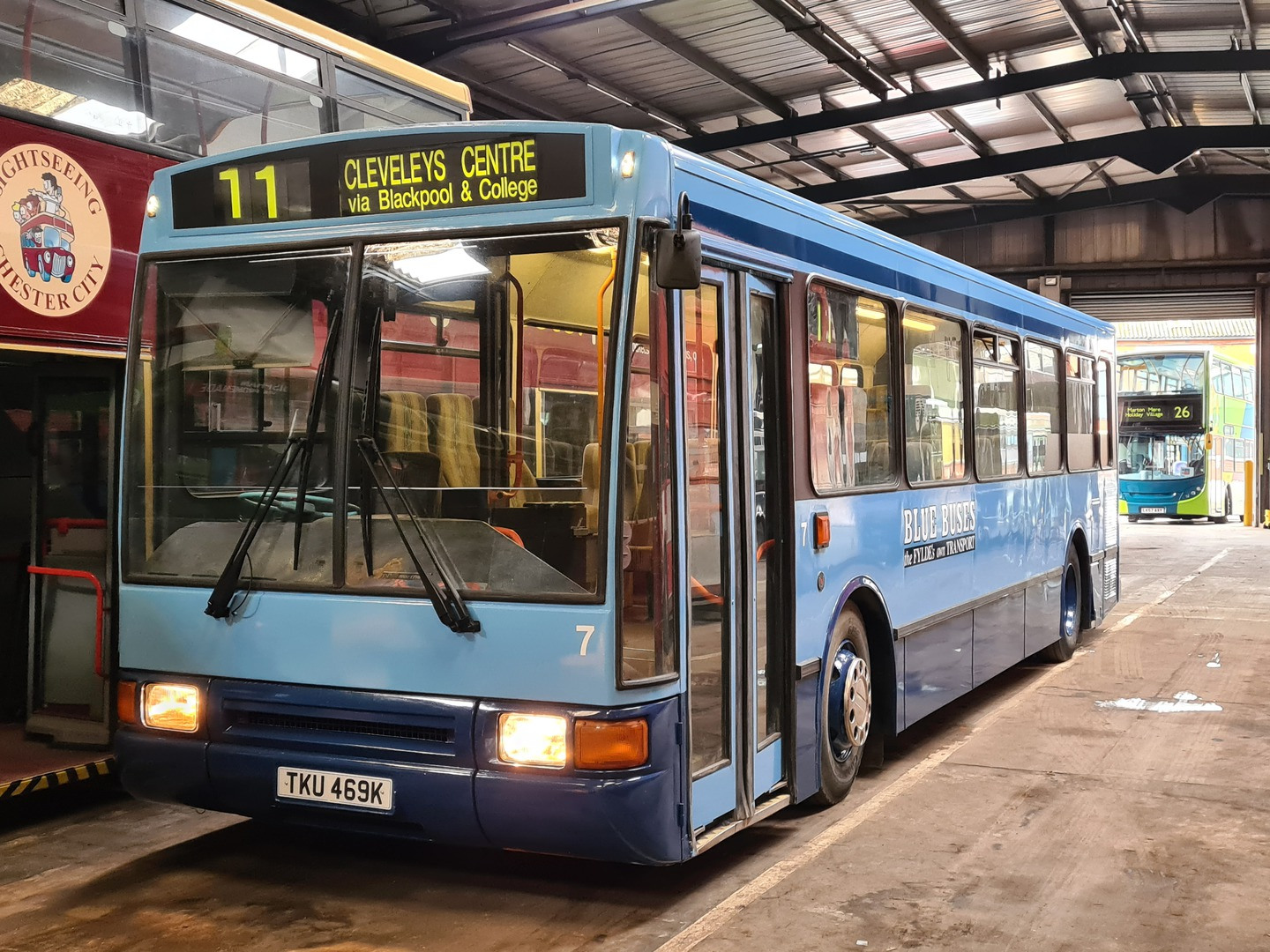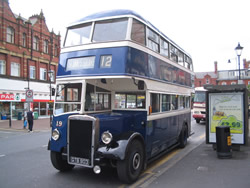
Lytham St. Annes was linked to Blackpool by a privately funded tramway in 1896, initially using gas traction, but later electrified. In 1920 the company was purchased by St. Annes Council which was merged with Lytham in 1922 to form Lytham St. Annes Corporation. Buses began operation between the two towns in 1923 and further local routes were added. In 1935 a ‘back road’ link between Blackpool and Lytham was introduced jointly operated by both Corporations. 1936/7 saw the staged closure of the tramway and its replacement by jointly operated bus routes. Blackpool and Lytham had not always been on friendly terms and the former attempted to take over the latter on several occasions.
By contrast to Blackpool, Lytham’s bus fleet was small – typically around 35 to 40 vehicles. With much summer duplication, buses were not unduly taxed and achieved long lives, if not necessarily high mileages. Leyland double deckers predominated after the war, just like Blackpool. One Person Operation commenced in 1969 and the town routes were all converted by 1972 with the Blackpool routes following during the 1970s. Local Government reorganisation saw a larger Fylde Borough Council absorb Lytham St. Annes and its bus operations.
Lytham 34
Between 1923 and 1935, Lytham St. Annes Corporation ran a fleet of small buses on four main services in Lytham St. Annes. 1935 saw the first route outside the boundary - route 11 from Lytham to Blackpool and in 1936/7 the tramway was replaced by routes 11A and 11B. This prompted a major fleet upgrade with 12 Leyland Lion single deckers and fourteen Leyland Titan double deckers arriving between 1935 and 1937.
All but one featured Leyland's "Gearless" transmission - an early automatic transmission that used a torque converter. Well suited to the flat Fylde Coast, similar vehicles were less successful in hilly areas such as Burnley and Sheffield, many being converted to conventional manual 'crash' gearboxes. The Gearless buses formed the back bone of the new fleet, until the post war expansion of the double deck fleet. Some of the Lions were were converted to open top configuration but it was not until 1957 that new replacement single deckers arrived and the last Lion survived until 1962.
34 was one of the 1936 batch of Lions, featuring Leyland bodywork rather than the Burlingham examples of previous years. £6,800 was spent on 3 Lions and 2 Titans, 34 entering service in October 1936. Initially operated in a white livery with blue relief, the balance changed in wartime to Lytham's familiar mainly blue scheme. After an uneventful life plodding sedately around the gentile twin towns of Lytham and St. Annes, 34 was retired in June 1957, replaced by three new Tiger Cubs.
Preservation beckoned and 34 joined the West of England Transport Collection in Winkleigh Devon in 1959 - probably its longest journey to date. It had a nomadic period passing through owners in Nottinghamshire, North Wales and Cheshire before remarkably being reacquired by Fylde Borough Transport (successor to Lytham St. Annes) in 1988. A full restoration ensued and 34 returned to the road in 1992.
Its new active retirement included special events and wedding hires, plus the occasional special appearance on local bus work. It passed to Blackpool Transport in 1996 when Fylde was absorbed by its neighbour and continued in use with its new owners. With further attention needed it was retired in 2006 and in July 2008 was acquired by LTT for further preservation.
Stored until 2015, 34 has received a complete repaint, interior restoration work and a full overhaul of its braking system in 2017. Further mechanical overhaul is required before 34 can operate again and in October 2019, 34 was transferred to the North West Museum of Road Transport in St.Helens for storage and display.
Lytham 19
Lytham St. Annes Corporation commenced running buses in 1923 shortly after it was formed in 1922 by merging Lytham and St. Annes councils. The latter had bought the privately owned tramway to Blackpool in 1920. Initially small single deckers were used on services around the two towns but in the 1930s longer routes to Blackpool were commenced, including a replacement for the trams. The first Leyland Titan double deckers were bought and the marque was to be associated with these routes for 40 years.
After World War 2, tourism returned and Lytham needed more double deckers with the first six delivered in 1946. These were of the new PD1 model which signified Leyland's return to bus building after wartime duties. It was quickly supplanted by a revised model (PD2) with a larger engine and synchromesh gearbox. The PD1s were unique for Lytham in having full crash gearbox (requiring drivers to ‘double-de-clutch when changing between each gear), which must have been a shock to the drivers used to Leyland's innovative "Gearless" automatic buses of the 1930s.
Wartime restrictions had not been completely lifted and No. 19 has no internal lining or ceiling panels. On its early post war buses Lytham specified leather seating upstairs and upholstery downstairs, both were finished in brown rather than the standard blue. Nevertheless, like the double deckers before and after it, No. 19 entered service on the core 11/11A routes. Eleven PD2s joined the fleet in 1948/51 that featured synchromesh gearboxes.
At this time the 11/11A only required eight buses in the winter the PD1s were quickly relegated to Lytham St. Annes local routes such as the 1A and 3. In the summer they would once again work the expanded 11/11A which was increased in frequency and also saw much duplication to cope with the additional tourist traffic. Later deliveries of new buses between 1957 and 1964 saw the Leyland bodied Leylands increasingly relegated to summer only work.
It was the need for additional summer vehicles that has secured several Lytham buses for preservation after lengthy service. The first PD1s did not come off until 1969 and No. 19 survived until September 1972 after just over 26 years in service. It was probably the last PD1 in use with its original owner. When sold in early 1973, No. 19 went for private preservation in the Midlands. Ten years later it passed to Lister, a Bolton dealer and was then purchased by the Rochester Motor Co becoming a promotional vehicle for this car dealership, though still in Lytham colours.
In 1988 it was sold for scrap but fortunately it was again secured for private preservation in Kent. Extensive restoration work was undertaken but in 1998 the bus was offered for sale again. It initially passed to a Croydon preservationist who returned it to full PCV Class VI status but later, in 2001, it passed to LTT member Graham Oliver.
No.19 finally returned to live on the Fylde coast in March 2003, joining the Lancastrian Transport Trust collection after an absence of exactly 30 years. LTT concluded the purchase from Graham during Summer 2005. During 2009 19 was treated to a lower deck repanel and full repaint into the later version of the standard Lytham livery, matching Lytham 70. In 2017, its lower deck seating was completely renewed.
Lytham 70
New in May 1964, it formed part of a trio of Leyland Titan PD2 buses with Massey front entrance bodies. Painted in the smart blue and white livery associated with the Lytham St.Annes areas, No. 70 was put to work on the trunk Blackpool to Lytham services 11/11A.
Plainer livery styles were adopted in later years as fashions changed and in May 1974 the Lytham undertaking was absorbed into Fylde Borough as a result of local government organisation. Retired in 1980, No. 70 later passed to a church for congregational transport although it suffered extensive vandalism and was later donated to the forerunner of the St. Helens Transport Museum.
Although some work was carried out, efforts were spasmodic and after being neglected for a number of years the Trust approached the museum to adopt the bus. This was agreed and No. 70 moved to Blackpool. No. 70 has received a considerable restoration effort to replace parts cannibalised whilst in store at the St.Helens Transport Museum. This has involved re-glazing, some repanelling and many lengths of new beading. Exterior work was completed in November 1999 allowing the bus to be repainted in original Lytham blue and white livery. Attention then turned to tidying up the interior.
The bus was submitted for an MoT test on 3 July 2000 and the successful pass allowed No. 70 to return to the road after an absence of nearly 20 years. The bus has been sponsored by Stardrops and authentic style adverts for the product now appear on the vehicle sides.In September 2005, No.70 was purchased from the St.Helens Transport Museum as part of a reduction in their core collection.
Lytham 77
Following four decades of standardisation on the Leyland Titan, its delisting in 1968 saw Lytham look for a new model when it decided to buy its first new double deckers since 1964. The Atlantean was nothing new though, having been introduced in 1958. Radically the engine was moved to the rear and the door to the very front allowing the driver to take over monitoring passengers boarding/alighting. The days of the "ding ding" starting signal from the conductor was coming to an end. Prudently Leyland kept its Titan model alongside the Atlantean for the more conservative operators (personified by Blackpool and Lytham), but in 1966 one person operation of double deckers was legalised. With the impending introduction of New Bus Grant offering firstly 25% and later 50% contribution to new OPO buses, the Titan was doomed.
Lytham therefore bought its first Atlanteans (75-77) in November 1970, but chose to run them as crew operated buses. Northern Counties built the bodies to an unusual design based on a style built mainly for Nottingham City Transport with an angled destination display over the windscreen. By contrast to their predecessors they were massive, seating 77 passengers.
OPO double deck operation finally started in March 1975 (two years before Blackpool Transport) when six more Atlanteans arrived and 75-77 were equipped with ticket machines and cash trays. Lytham St.Annes Corporation had become Fylde Borough in 1974 and 75-77 gained the new blue, white and yellow livery in 1977 on their first overhaul.
75 and 76 were sold in 1983 but 77 survived until deregulation and a massive increase in the Fylde fleet, including some older vehicles. 77 continued in regular service, though largely confined to school specials by the late eighties. From 1990 the bus adopted a further role as one of the Atlanteans dedicated to the Blackpool promenade service that competed with the resort's famous tramway system.
No. 77 was repainted in dark blue livery with yellow front and 'Coastliner' branding. Later it was renumbered 58 and after a spell operating in an all-over advert for Wyre Attractions it succumbed to a multi-coloured 'RollerCoaster' livery.
The bus eventually passed to Blackpool Transport upon their take-over of Fylde Borough Transport ("Blue Buses") in 1994, when it was renumbered 458 and repainted in the dark blue and cream livery adopted for Squires Gate based operations.
The bus was withdrawn from service in October 1996 and purchased by the Trust for preservation the following year. During 1998 some minor work was undertaken on the vehicle prior to repainting in original blue and white livery, sponsored by 'The Gazette' newspaper. However, a need was identified for the front end of the bus to be completely rebuilt and from 1999, No.77 was stored at the St. Helens Transport Museum. It returned to the Fylde coast in March 2003 for further storage at our Clifton Road building.
Restoration to its 1977 condition as Fylde 77 commenced in 2020 and rebuilding of the front end has already started.
Fylde 7
Fylde Borough Transport was privatised in 1986 and under the branding of “Blue Buses” the operation expanded with both contract work around the Fylde coast and direct competition with Blackpool Transport. The operation remained under Fylde council control until 1993 but was then purchased by Blackpool Transport the following year and the operations consolidated.
Following on from the refurbishment of mid-1970s Atlanteans by Northern Counties, “Blue Buses” embarked on perhaps its most radical refurbishment; rebuilding four long wheelbase Leyland Atlanteans. They had been new to Bradford Corporation as trolleybus replacements, but had ended up at Hull, a source of many second hand Atlanteans for Blue Buses. They were acquired and driven to a breakers in Barnsley who removed the bodies. The chassis were then delivered to Fylde in early 1992, overhauled and then despatched to Northern Counties to be rebodied as single decks with their contemporary “Paladin” style.
Numbered 4-7, the first of the buses entered service in June 1993. Intended for trunk routes 11/11A they allowed the withdrawal of the 18-year old Bristol REs. Unfortunately their capacity was too low and in early 1994 they were moved onto quieter routes. On takeover by Blackpool Transport in 1994 they became 134-137 in their numbering system and were repainted in their green & cream livery. However, they soon were relegated to occasional use as new low floor Optare Excels arrived.
During 1997 they regularly ran on the Promenade Service 1, releasing double deckers for school work and were delicensed at the end of October. Their first of several reprieves occurred courtesy of the Blackpool Tramway which required partial bus replacement in December. All four were reinstated once again in May 1998 to work summer services from Squires Gate. They tended to flit between the two depots according to driver availability for the Zoo service 21 and a third retirement took place in December 1998 after a rather unproductive November.
The next reprieve in June 1999 saw the batch once again in use on the Promenade service but this time from Rigby Road. This was short-lived for at the end of August 1999 they were withdrawn and sold to a dealer in October, ending an unusual and somewhat unproductive career.
7 passed to an independent operator but was acquired for preservation in 2008. Stored until 2020, 7 was returned to "Blue Buses" livery in September 2020 and will feature in FTT events from 2021.

